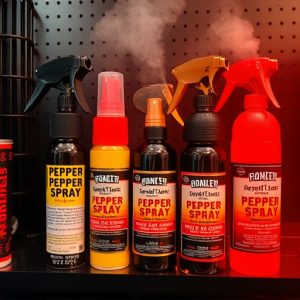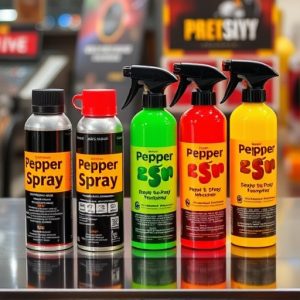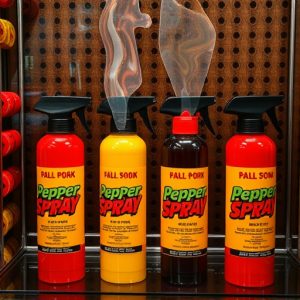Decoding Pepper Spray Display Technology: Mechanisms and Retail Presentation Strategies
Pepper spray displays are sophisticated educational and training tools that simulate real-world pep…….
Pepper spray displays are sophisticated educational and training tools that simulate real-world pepper spray use, providing law enforcement and the public with insights into self-defense and safety. These systems feature an oleoresin capsicum (OC) solution canister, actuator, propellant, and aiming adapter to accurately mimic the activation, dispersion, and irritating effects of actual pepper spray on the eyes, skin, and respiratory system of an attacker. They offer adjustable settings for flow rate and spray pattern, along with sensors that track range, trajectory, and concentration for detailed training feedback. The evolution of these devices from basic deterrents to advanced self-defense tools is marked by improvements in accuracy and the integration of features like UV markers for law enforcement use, disorienting LED lights, safety attachments, and laser sights. Retail presentation of pepper spray displays should prioritize safety and clarity, with strategic placement, informative signage, and interactive demonstrations to educate consumers on their proper use and benefits. Comprehensive marketing strategies that include realistic scenario depictions further enhance consumer understanding and awareness, ensuring a well-informed approach to personal safety through the responsible use of pepper spray displays.
Exploring the dynamic world of self-defense, this article delves into the intricacies and advancements of pepper spray displays. We’ll unravel how these devices function, the critical components that define their efficiency, and the transformative journey of pepper spray display technology from its rudimentary beginnings to cutting-edge solutions. Additionally, we’ll guide you through the best practices for showcasing these essential self-defense tools in retail settings, ensuring both informative and compelling presentations. Join us as we illuminate the vital role pepper spray displays play in personal safety and their evolution in technology.
Understanding the Mechanism and Components of Pepper Spray Displays
Pepper spray displays are sophisticated devices designed to demonstrate the activation, dispersion, and effects of pepper spray in a controlled environment. These displays offer an educational platform for law enforcement training, self-defense education, and public safety awareness. The mechanism behind pepper spray is a finely tuned system that propels a concentrated oleoresin capsicum (OC) solution towards a target area. This solution, upon contact, irritates the eyes, skin, and respiratory tract of an assailant, temporarily impairing their vision and ability to breathe.
A typical pepper spray display unit consists of several key components that work in unison to simulate real-life scenarios. These include a canister filled with the OC solution, an actuator that releases the spray when triggered, a propellant to force the spray through the nozzle, and an aiming adapter to direct the spray towards a specific target. The display also features adjustable settings to control the flow rate and pattern of the spray, allowing users to observe different scenarios and outcomes. Additionally, the display can be equipped with sensors to monitor the range, trajectory, and concentration of the spray, providing valuable data for training purposes. Understanding these components and their interactions is crucial for effectively utilizing pepper spray displays in various settings where personal safety or law enforcement training is paramount.
The Evolution of Pepper Spray Display Technology: From Basic to Advanced Models
The evolution of pepper spray display technology has marked a significant advancement in personal defense systems, transitioning from rudimentary to sophisticated models. Early iterations of pepper spray displays were simple in design, primarily consisting of a canister with a dispenser nozzle. These basic models relied on a user’s dexterity and reaction time to deploy the contents effectively. As technology progressed, the designs became more ergonomic and user-friendly, incorporating aimed streams for greater precision during confrontations.
Today’s pepper spray displays are the pinnacle of this evolution, offering advanced features such as ultra-violet (UV) marking capabilities to aid law enforcement in identifying and apprehending assailants. They also integrate bright LED lights that can disorient attackers from a distance before the chemical agent is even released. Furthermore, many modern pepper spray displays come with safety mechanisms like keychain attachments or laser sights to enhance accuracy. These innovations underscore the shift towards more effective and safer self-defense solutions, exemplifying the remarkable strides made in pepper spray display technology.
Effective Strategies for Presenting Pepper Spray Displays in Retail Environments
When showcasing pepper spray displays in retail environments, it’s crucial to prioritize safety and clarity for potential customers. Strategic placement within the store can enhance visibility and accessibility of the products. Positioning displays at eye level or slightly above, in well-lit areas with clear signage explaining the use and benefits of pepper spray, helps draw attention. Educational materials or interactive components, such as demonstration units where allowed, can significantly increase engagement and understanding of the product’s value for personal safety.
In addition to physical placement, merchants should utilize in-store promotions and educational campaigns to highlight the importance of self-defense tools like pepper spray. Training sessions or informational pamphlets that detail proper usage and legal considerations further empower consumers to make informed decisions. By combining these strategies with dynamic visual elements and real-life scenarios depicted in marketing materials, retailers can create an effective and responsible sales environment for pepper spray displays. This approach not only fosters consumer confidence but also reinforces the responsibility of using such products for protection.


